
Features
Aggregates
Technology
Screening Goes High Tech
Today’s new screen designs incorporate new materials and innovative features to boost production
July 25, 2013 By Treena Hein
The selection of screens on the market in Canada has never been greater,
allowing companies better-than-ever opportunities to maximize
production profits.
The selection of screens on the market in Canada has never been greater, allowing companies better-than-ever opportunities to maximize production profits. Modular synthetic screen media is one of the newest screen developments available. Their increased use, says Alex Caruana (Ontario regional manager for Polydeck) has led to innovations that allow greater open screening area and reduced blinding, aspects that contribute to greater productivity.
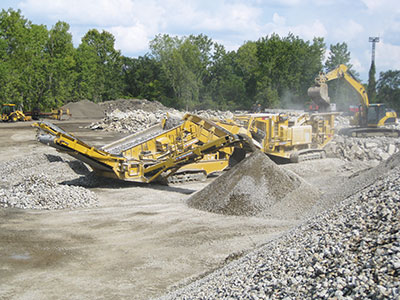 |
|
| A Screen Machine 4043T Impact Crusher feeds recycled concrete to the Spyder 516T double deck screening plant.
|
Modular synthetics make for much quieter screen plant operation, and cut accident risk as well, says Vito Maraventano, Polydeck regional manager for Quebec. “Modular synthetic screen media has eliminated the need to use heavy machinery and a crew of people for media installation and removal,” he explains, “making the change out and maintenance processes not only simpler but safer.”
Injection moulding is another screen development of note in Caruana’s opinion. “We are the only screen media manufacturer to injection mould all our rubber and polyurethane screen panels, which allows greater consistency and more design options,” he notes, including the ability to mould different surface features like dams and skid bars directly into the screen panel construction.
“One of our exciting new developments is our Armadex product line of large format bolt-down rubber screen sections for extreme scalping applications,” Caruana says. With openings as small as 0.1 millimetre, they allow screening of frac sand applications (even scalping 20 mesh on the wet side, says Maraventano), which helps companies drastically cut drying costs.
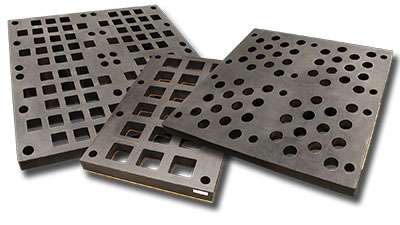 |
|
| The new Armadex uses Binary Injection Moulding to produce a screening product for extreme heavy-duty scalping applications.
|
Gary Pederson, vice-president of sales at Major Wire Industries, agrees that developments with synthetic screen products have been very important for the aggregate industry over the past few years. “There have been many improvements to existing screen media during the past decade, but none more significant than replacing tensioned woven wire screens with self-cleaning screens, with vibrating wires bonded to either polyurethane or rubber strips,” he says. “They allow each wire to vibrate independently, resulting in far more in-spec product passing through to the next screen deck.” Pederson adds that due to the increased vibration of the individual wires, producers have also found that typical blinding, pegging and clogging common with woven wire screens has been significantly reduced or eliminated. “Many producers who were forced to shut down altogether or stop frequently to clean their screens in wet weather can keep screening with these products,” he notes.
Polyurethane or rubber self-cleaning wire screens also last much longer than woven wire, Pederson says, because of the increased open area and flat configuration (versus the crimped configuration of woven wire). “Synthetic self-cleaning tensioned screens have been frequently documented to produce up to 40 per cent more production per hour and have three-to-four times the lifespan of woven wire,” he explains. “More recently, this tensioned screen media solution has been adapted to polyurethane panels where throughput is typically limited in exchange for maximum wear life.”
Major Wire pioneered tensioned technology in North America in its Flex-Mat products, notes Pederson, and the company has gone on to customize the same tensioned version to fit modular panels, providing far greater throughput with similar in-spec wear life and up to a documented 50 per cent production increase. “Flex-Mat 3 High-Performance screen media, which is available in tensioned and modular formats, has been used in over 25,000 applications,” Pederson says. “Flex-Mat 3’s polyurethane strips also deliver precise passing and remove fines from retained material, often allowing producers the option of eliminating the washing process.”
Tony Weir, technical sales and applications manager at Powerscreen, also sees self-cleaning screen media as an important industry development. “The introduction of rust-free compound self-cleaning screen media and the use of finger and punch plate in recycle applications are the most significant improvements,” he says. “They have moved the boundaries for material separation, which had previously been un-screenable in some cases.”
Powerscreen manufactures circular throw high-amplitude scalping and fine-sizing screens as well as combined circular/linear and elliptical motion screens. In Weir’s mind, features that make Powerscreen screens ideal for quarry use are reliability, high output potential, the capabilities to adjust the settings and more accurately size materials to meet different specifications.
“The screens we offer to the market have changed significantly in the past five to 10 years because of better design, smarter use of higher grade metals and more intuitive electrics and hydraulics,” Weir notes. “[These] have all contributed to reduced machine complexity, making them more user-friendly and more productive with lower running costs.” Improved Powerscreen design features have also allowed the screens to be used in new applications – for example, feed sizes of up to 750 mm cubical and 1 m x 250 mm slab with a separation point at between 300 mm and 0.5 mm.
Hybrid and metal screens
Trends in aggregate processing over the past few years, notes Weir Minerals North America marketing communications manager Lori Masters, have reflected an increased use of modular media systems and the ability to produce finer openings in polymer screen media. “The use of ‘hybrid’ screen media systems combining the open area benefit of wire cloth and the increased wearability of polyurethane has also gained market share,” she observes. “We have the distinct ability to offer all media types, so dependent on the customer’s needs we will recommend the best solution, whether that be better wear, to solve a specific challenge such as blinding, the need to increase throughput and so on.” Weir Minerals North America manufactures a wide variety of screen media, including woven wire cloth, modular, bolt down and hooked rubber, and both modular and hooked polyurethane.
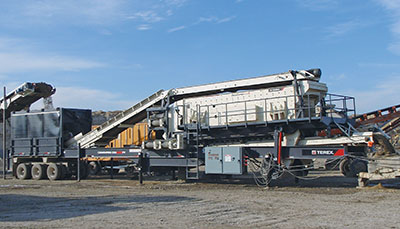 |
|
| The new Terex Cedarapids CRS6203FV hydraulically lifts the LJ-TSV Screen up to 10⁰ in 2.5⁰ increments.
|
The company has expanded its product offerings by adding a more complete line of hybrid and specialty screen media products. Weir Minerals has also improved the quality of its screen materials by adding improved compounds specific to its polymer products. “We have made significant improvements to our production processes,” Masters explains, “translating to better lead times and quality for our clients.”
Metso is another company currently offering hybrid screen media, with its Trellex Poly-Clean product. Metso calls it “the latest innovation in screen media,” combining the wear-resistant properties of polyurethane with the open area of wire media, which will last longer and outperform traditional wire cloth. Poly-Clean has a flexible inner core that allows greater vibration of the individual wires. This inhibits the buildup of material over the screening surface, preventing blinding and increasing the efficiency of the deck. The inner core is capped with a wear-resistant layer that maximizes the life of the media. Four weave configurations are available to allow tailoring for specific applications.
The polyurethane strips in the Poly-Clean screens allow customers to monitor wear life and plan for future change outs. There are two wire options available. Ultraloy, an alloy developed by Metso, provides longer wear life than other alloys used in the industry and combines abrasive resistance with ductility. The other wire option, Astroloy, is a “full hard” stainless steel that can be used in very abrasive applications or with excessively sticky material. The wear surface of Astroloy remains smooth through its service life, preventing material adhesion.
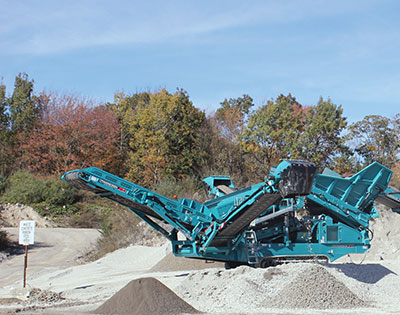 |
|
| The Powerscreen Warrior 1400X, provides high output potential and accurate sizing of materials to meet different specifications.
|
Metso’s Trellex HiPer is its most advanced synthetic screen product line, grouped into four series that all offer zero interruptions caused by pegging or blinding. Trellex LS HiPer Flow modules have at least 20 per cent more effective open area compared to corresponding Metso LS standard modules. They feature “dual hardness” technology to ensure that the wider and more productive open area does not come at the expense of wear life. Trellex LS HiPer Life is built tough for maximum load handling, and Trellex LS HiPer Clean is designed for screening fine materials. It has a unique combination of injection-moulded modules with moulded apertures and superior flexible rubber material that stays clean in the most challenging conditions, including the screening of high-humidity materials. Trellex LS HiPer Drain offers exceptional dewatering with injection-moulded polyurethane with the highest possible accuracy in aperture size and module dimensions.
Over the last 10 years, Screen Machine Industries has moved from making predominantly topsoil screens to mostly screens for aggregate processing (portable metal vibratory shaker screens and trommel screens). Director of marketing Matt Johnson says the company has adapted to changing innovations and technologies and tried to incorporate those expected to benefit its customer base. One of Screen Machine’s newest and most important developments for quarry aggregate processing is called “Smooth Start Technology.”
“This is a spring-actuated eccentric that serves to eliminate the slow speed, violent banging experienced at initial startup and shutdown of the machine,” explains Johnson. “It saves wear and tear not only on the welded structure, but on all of the components as well.”
This technology also requires less overall operating horsepower, says Johnson, which of course provides better fuel economy and lower costs. “In addition, we utilize a U.S.-made Grade 80 steel with a tensile strength of 80,000 psi compared to the A36 steel (36,000 psi) that our competitors use,” he says. “This makes our equipment more robust and durable, and greatly extends the usable life of the structure.”
Ed Sauser, product line manager at Terex Minerals Processing Systems (including the Simplicity and Cedarapids brands), views highly flexible steel wire media as the most significant technological development in recent years. “These products are more resistant to blinding and plugging than traditional wire mesh while maintaining high percentage of open area,” he notes. “The low G inclined screens work very well in many applications and are normally a lower investment than the high G horizontal screens. However, the high G screens can produce more accurate sizing and operate in tougher applications than low G inclined screens.”
The company’s triple shaft oval stroke screens are well known, says Sauser, to be “top of the line” in performance and longevity. “A significant portion of the market is the replacement screen business, so matching a particular existing envelope is a consideration,” he notes. “Our ability to customize products is key for providing replacement screens.” Terex has developed more selection in high G oval stroke screens for mobile plants as demand for that has increased.
Its newest screen product is a triple shaft variable (TSV) slope screen, which combines the capabilities of both high G horizontal screens and sloped screens to handle the largest range of applications. “We have designed two new portable plants (CRS6203V and CRS6203FV) specifically for these new TSV screens,” Sauser notes, “that can hydraulically adjust the screen position for most any portable plant application.”
| More Screening Technology Here’s a look at some of the other screen media technologies available in Canada’s Rock to Road market: |
Print this page
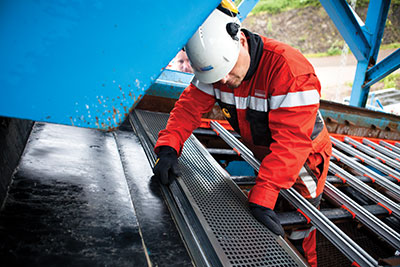 Sandvik
Sandvik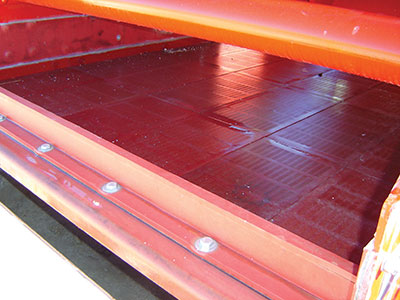 McLanahan
McLanahan